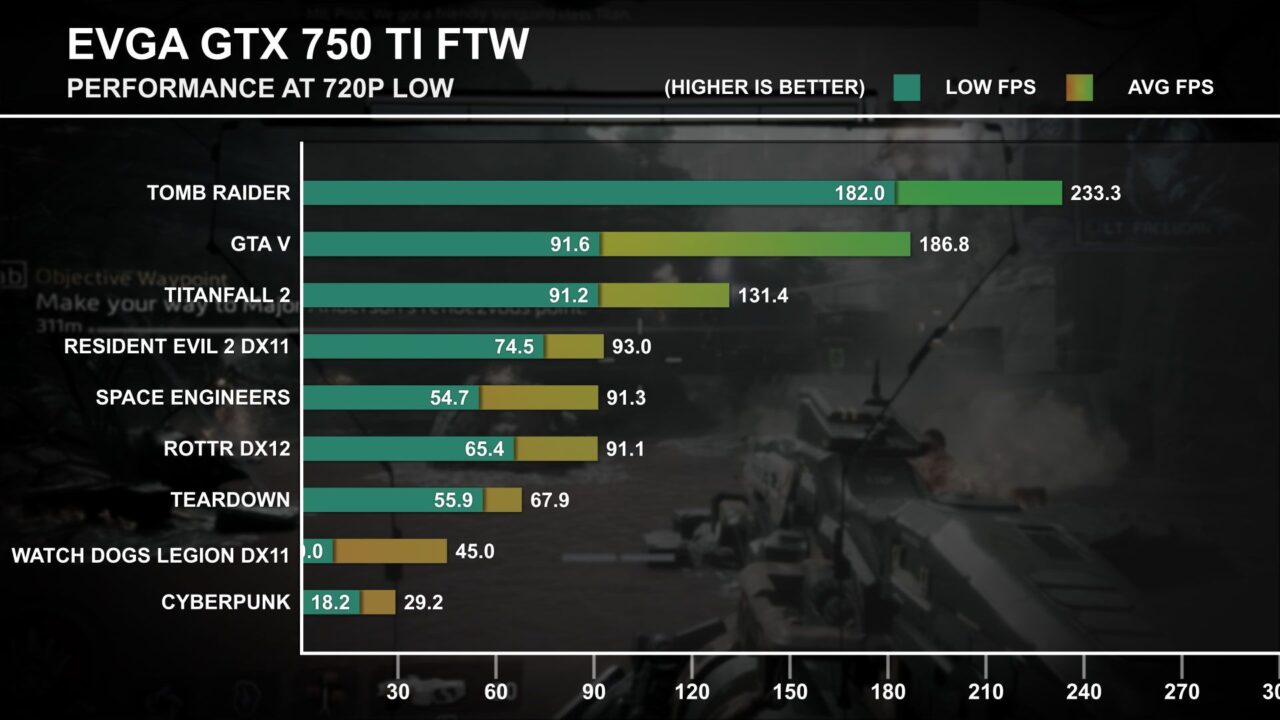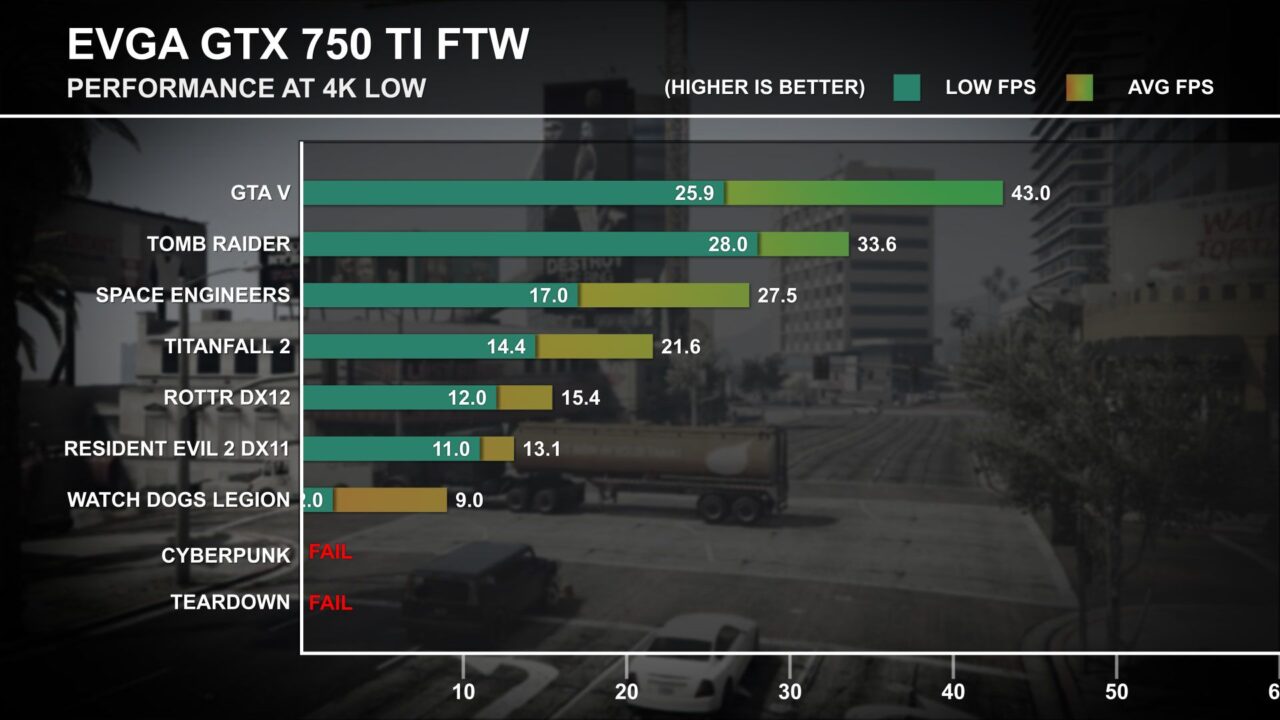
Tested in 9 Games 720p -> 4K + Power, Noise, Thermals
PC Gaming’s most famous budget graphics card is NVIDIA’s 2014 smash hit, the GTX 750 Ti. It was the first GPU based on NVIDIA’s upcoming Maxwell architecture, but wasn’t intended to replace the top-end GTX 780 Ti. Instead, it slotted in just below the already-popular GTX 760, offering lower performance but much lower power consumption.
Prefer video reviews? Check it out on YouTube: https://www.youtube.com/channel/UClfSud8tb1lzOLumKOpM0mw
The sample I have on hand is one of the best, EVGA’s GTX 750 Ti FTW, so this will give the budget GPU its best chance to shine. In this review I’ll be running it through its paces in a suite of 9 games, each tested at 720p, 1080p, 1440p, and 4K resolutions at both Low settings and High settings. Keep an eye out for my upcoming DX11 vs DX12 comparison and 20+ game testing.
A LOOK AT THE GTX 750 TI FTW.

First up, let’s take a look at the card. The first thing that stands out about EVGA’s FTW model is the dual axial fan ACX cooler. This cooler wouldn’t be out of place on something much more powerful like the GTX 980.

Display connectivity is handled by a trio familiar to many budget GPUs: a DVI, HDMI 1.4a, and DisplayPort 1.2.

Despite the powerful cooler, power input is satisfied by just one 6-pin power input.

Now, from here the card’s more budget-oriented aspirations become clear. The PCB looks fairly similar to the GTX 645 I’ve reviewed previously.
GTX 750 TI FTW TECH SPECS.

Upon first inspection, it may seem like the GM107 would deserve comparison more to something like the GTX 650 than the GTX 660. However, the secret weapon for Maxwell here is its massive generational improvement in many areas: IPC, core clock, and memory compression.
Another advantage of the GTX 750 Ti being based on the Maxwell architecture is longer driver support than its Kepler stablemates. In fact, it still receives the same GeForce game-ready driver releases that the current RTX models receive.
Shout out to TechPowerUp for their awesome GPU specs database.
GTX 750 Ti FEATURE SUPPORT.

Undeniably, this 9-year-old graphics card is lacking many of the modern features that something like RX 6900 XT takes for granted. Adaptive sync (FreeSync) support is missing, Pascal is the oldest NVIDIA GPU that supports it. Integer scaling is missing, Turing or newer is required for team green options, though all AMD GCN cards do support it. One great feature pre-RDNA AMD cards don’t support is enhanced spatial upscaling. In this case NVIDIA Image Scaling (NIS). It is no replacement for tech like DLSS 2 and FSR 2, but can be used in any game. Advanced features like Noise Suppression, Ray Tracing, Re-Sizeable Bar are of course not featured. Video encode/decode features full support for H.264, but only hybrid software support for H.265.
THE TEST SYSTEM.

Ideally I could benchmark the GTX 750 Ti in the exact configuration somebody would realistically use it. However, my ultimate goal is to produce data that I can later compare and contrast other GPUs against. To that end the test system aims to eliminate all possible bottlenecks other than the GPU.
Therefore, I’ve upgraded the system some since the last review. The CPU is now the Ryzen 9 5900X, and the RAM has been upgraded to 32GB, still DDR4 3200 cl16. I’ve also changed motherboards to the ASUS ROG Crosshair VI Hero. While this board only supports PCIe 3.0, it does support SLI, so look forward to some SLI / Crossfire testing in the future.
GTX 750 TI FTW IN PRODUCTIVITY
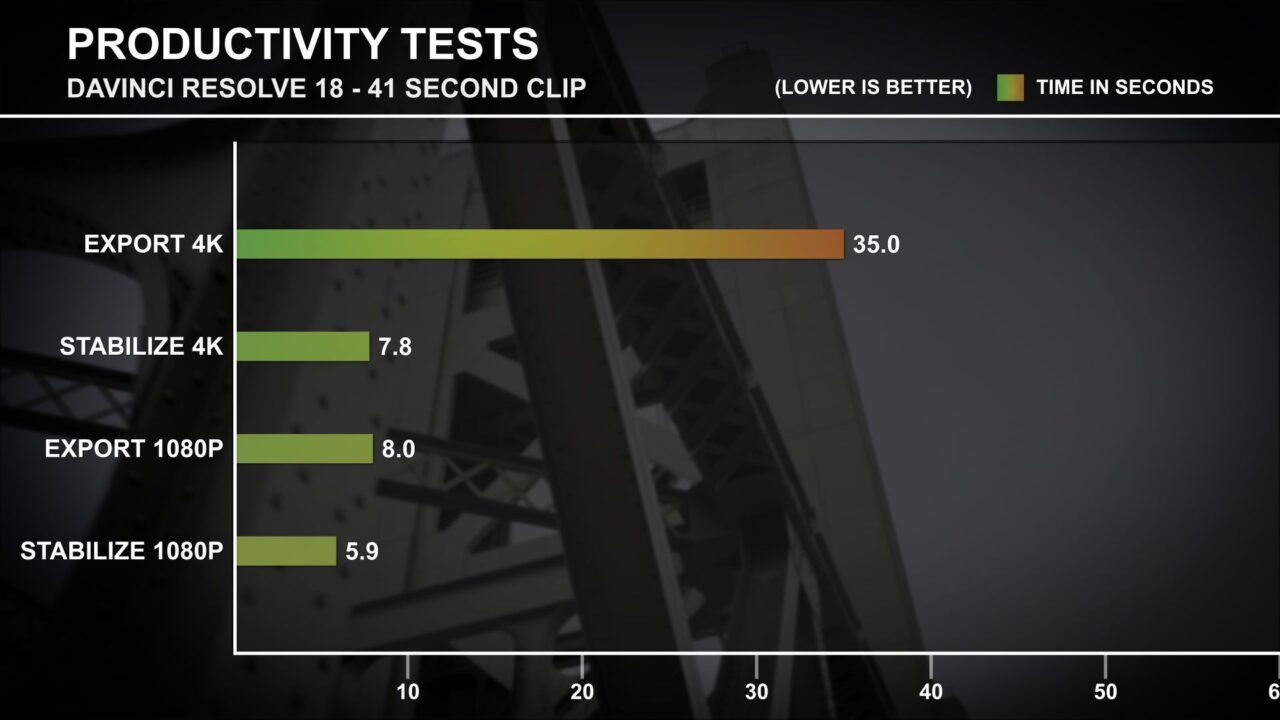
Unlike the GTX 645 I had reviewed before, the GTX 750 Ti had no troubles with DaVinci Resolve. Despite the limited 2GB VRAM, GPU acceleration within the video-editing software was quite effective. Using two different sizes of the same 41 second clip, tests were conducted in both 1080p24 and 4K24 timelines. First the time to stabilize the unedited clip was recorded, using DNXHR optimized media to negate any decoding bottleneck. Then, the stabilized clip had a corrective LUT applied, and the time to export was recorded.
We see here that even at 4K, the GTX 750 Ti FTW managed to export the modified clip faster than 1:1.
Finally, let’s get into the game benchmarks.
TOMB RAIDER.
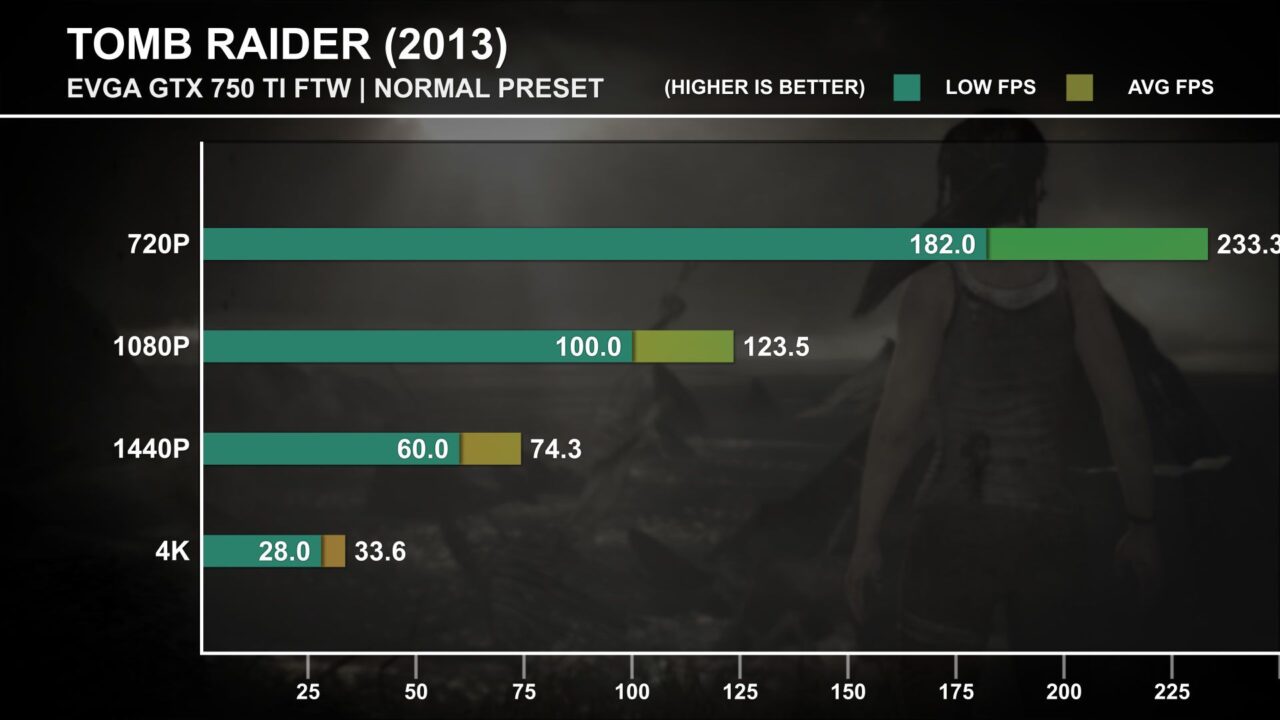
Starting out with 2013’s Tomb Raider reboot game. Using the Normal preset we see great results at 1440p and below, keeping FPS above 60 at all times. At 4K, the performance could give a last-gen console a run for its money, but a lower resolution would be more prudent.

Upgrading to the Ultra preset, performance drops roughly 50% across all resolutions. Still, 1080p Ultra averages over 60 FPS, providing a great visual experience.
RISE OF THE TOMB RAIDER – DIRECTX12.

I’ve tested the GTX 750 Ti FTW in Rise of the Tomb Raider using both DX11 and DX12, but found DirectX12 to provide better performance. I will be doing another article to compare both APIs in 6 games to get a closer look at how they compare on this GPU.
2015’s Tomb Raider sequel is decidedly more demanding, using the Low preset framerates don’t break 60 FPS even at 1080p. 33 FPS on average at 1440p gives an experience better than Cyberpunk on XBOX ONE, but that’s a low bar.

Moving to the High preset doesn’t help matters, and results in 1080p performance falling to just 38 FPS on average.
GTA V.
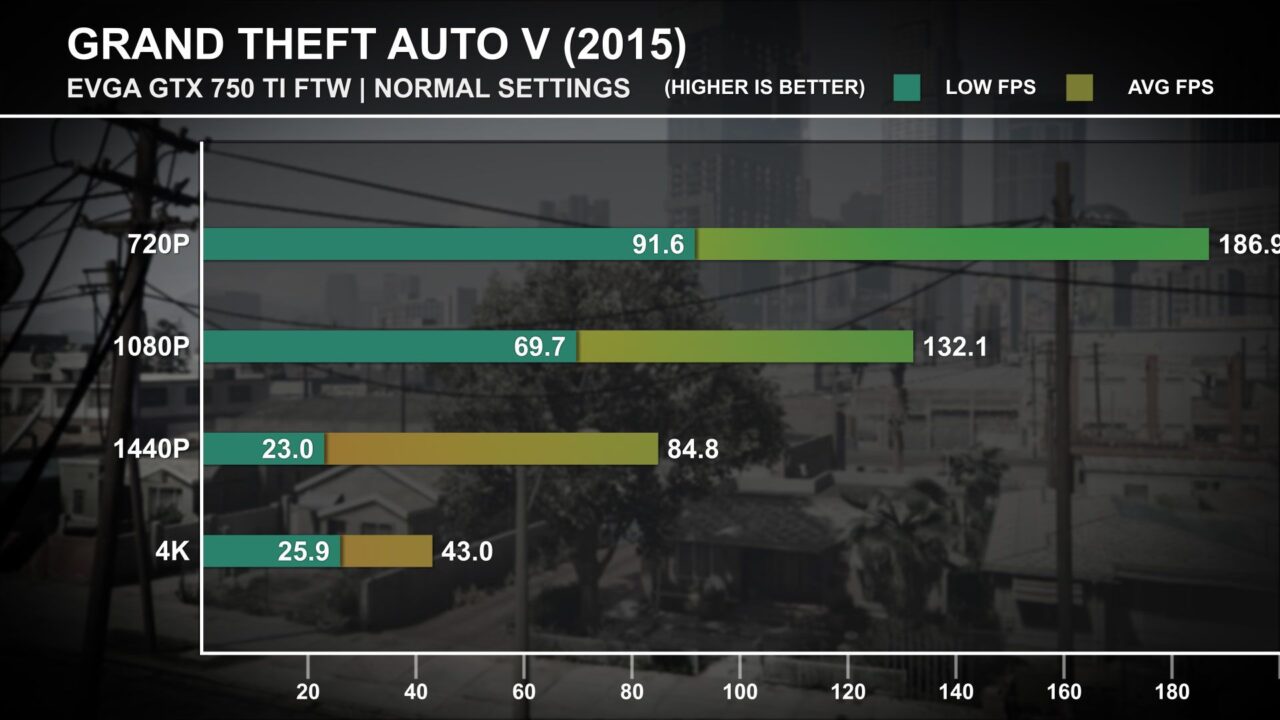
2015’s PC release of Rockstar’s GTA V is still a massively popular game, and even using Normal graphics settings is a nice looking one. Here we see solid framerates at 1080p, keeping FPS above 60 at all times in the benchmark. Performance at 4K wasn’t entirely objectionable either.
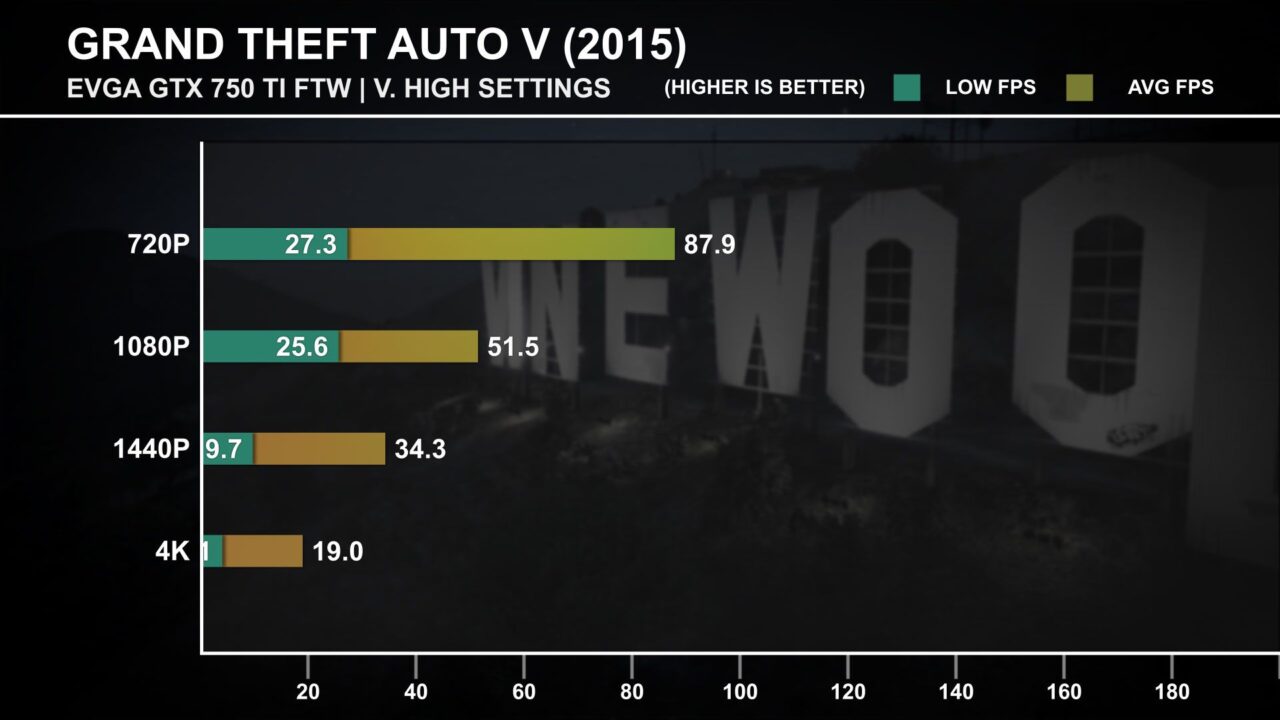
Unfortunately the 2GB VRAM buffer leaves something to be desired when using the Very High settings in GTA V. Minimum FPS suffers worst, resulting in a failure to maintain over 30 FPS at all times even at 720p.
TITANFALL 2.

The GTX 750 Ti has an easy time with Titanfall 2, delivering playable results even at 1440p. At 1080p the game felt great with over 70 FPS on average, though some quality settings like texture resolution could stand to be upgraded some.

Unlike GTA V, the High settings are more kind to this GPU. Performance does fall by nearly 40%, but minimums only drop by around 30%. The visual upgrade is substantial, particular in texture resolutions. Overall, the experience at 1080p is rather solid.
SPACE ENGINEERS.

The Indy space-sandbox title from 2019 does have a 120 FPS limit, though in the tested use-case that’s not a concern. Performance at 1080p is playable, though more demanding scenes will tend more toward the 40 FPS minimum than the optimistic 68 FPS average.

Switching to the High preset once again sees the GTX 750 Ti outside its comfort zone. In Space Engineers, the High preset fails to fully load in the higher quality textures. Therefore even objects in close proximity to the player end up looking very blurry.
RESIDENT EVIL 2 REMAKE.

Capcom’s 2019 remake of Resident Evil 2 is yet another title that support both DX11 and DX12. That is, at least, when using the original build rather than the newer RT build. For this I’ve found DX11 to deliver better performance for this GPU.
Using the Performance Priority preset, The GTX 750 Ti FTW manages surprising results, especially considering how good the game still looks. 1080p manages a smooth 51 FPS on average, with minimums not far behind at 42 FPS.

The Graphics Priority preset proves to be too much for the baby Maxwell GPU. 720p is required to keep averages above 30 FPS, but even it fails to maintain over 30 FPS at all times.
CYBERPUNK 2077.

Speaking of games being too much for this budget GPU, 2020’s Cyberpunk 2077 keeps that trend alive. Even at the Low preset, 720p fails to meet 30 FPS on average. It’s clear that the GTX 750 Ti FTW simply doesn’t have the horsepower required for a playable experience with these settings.

Naturally, the High preset sees performance slide further. 720p fails to manage even 20 FPS on average.
Of course, this title does feature FSR 2 support, and the graphics settings could be further reduced. So it is possible to get more than 30 FPS on average, but the visual trade offs would just be too great.
WATCH DOGS: LEGION

In contrast to Cyberpunk, one could make a case for playing Watch Dogs Legion on this GPU. Minimum FPS struggles, particularly when using the DX11 API, but an average FPS of 45 at 720p could be playable territory for those determined to play the latest in the franchise.
There is more hope to be had in the form of the game’s built-in resolution scaling. It is a temporal upscaler, with the option to reduce the resolution as low as 25%.

Watch Dog Legion’s High preset sees performance at 720p drop another 24% on average, though still managing 34 FPS on average.
TEARDOWN.

The last title tested in this review is the 2020 Indy game Teardown. Using the Low settings, the GTX 750 Ti does manage playable performance at 720p. At 1080p, an average framerate of just 34 isn’t ideal, but the game’s resolution scaler could be adjusted to get a little more performance.

The High settings turn up the visuals, at the cost of even lower performance. Performance at 720p drops below 60 FPS on average to just 42 FPS, and 1080p averages drop below 20 FPS.
GTX 750 TI FTW SUMMARIES.

Looking at the average performance of all 9 games for each resolution and quality combination tested, we can see that the GTX 750 Ti does fair well up to 1080p Low. The High settings generally punish it substantially because of its lacking 2GB VRAM, so it’s best to keep the graphics settings dialed down.
Now, let’s take a look at performance in all 9 games at each resolution:
PRICE TO PERFORMANCE.

Based on an average sale price on Ebay of $54.59 US shipped, I’ve calculated the GTX 750 Ti FTW’s price per FPS based on the 9-game average data collected for this review. We can see that at 1080p using the Low settings we average just 84 cents per FPS, but as quality settings and resolution increase, price to performance slides drastically.
GTX 750 Ti FTW IN SYNTHETIC 3D BENCHMARKS.

Running the GTX 750 Ti FTW through all the standard 3DMark tests shows expected results. In 3DMark Fire Strike, it scores roughy 5,000 points, and in Time Spy roughly 1,400 points. 3DMark Port Royal won’t run due to the card lacking DX12_Ultimate support.

Next up is testing with the trio of Unigine benchmarks. First, Heaven Extreme runs at an average of 30 FPS for a score of 751. Valley Extreme HD runs at 23.9 FPS for a score of 1001. Lastly, Superposition using the Medium preset runs at 24.4 FPS for a score of 3267.
GTX 750 TI FTW OVERCLOCKING.

The overclocking experience was fairly straight forward, especially since adjustable parameters are limited to just core and memory clock offsets. Power target is limited to 100%, and voltage does not allow any increase. Thankfully, this card doesn’t reach 100% power limit even when overclock. Here I’ve managed to raise the core clock by nearly 11%, and the memory clock by nearly 26%.

Using 3DMark to assess the performance uplift from the overclock, we can see a noticeable increase. Vantage Extreme sees an increase of 15% to over 13,300 points. Fire Strike graphics score goes up by over 13%, breaking the 5000 barrier for 5658 points. Time Spy also sees more than a 13% increase to 1596 points.
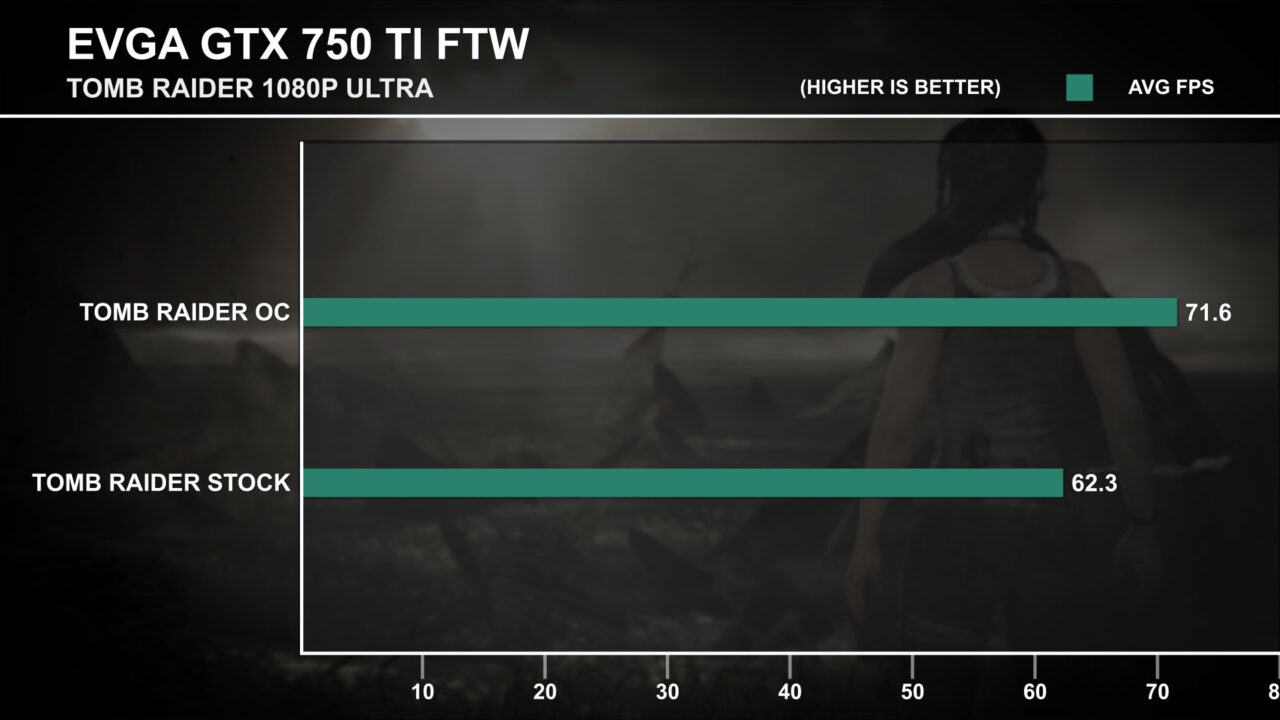
Testing Tomb Raider at 1080p Ultra see performance increase similarly to 3DMark Vantage; a 15% increase from 62 FPS to 72 FPS.
GTX 750 TI FTW POWER DRAW.
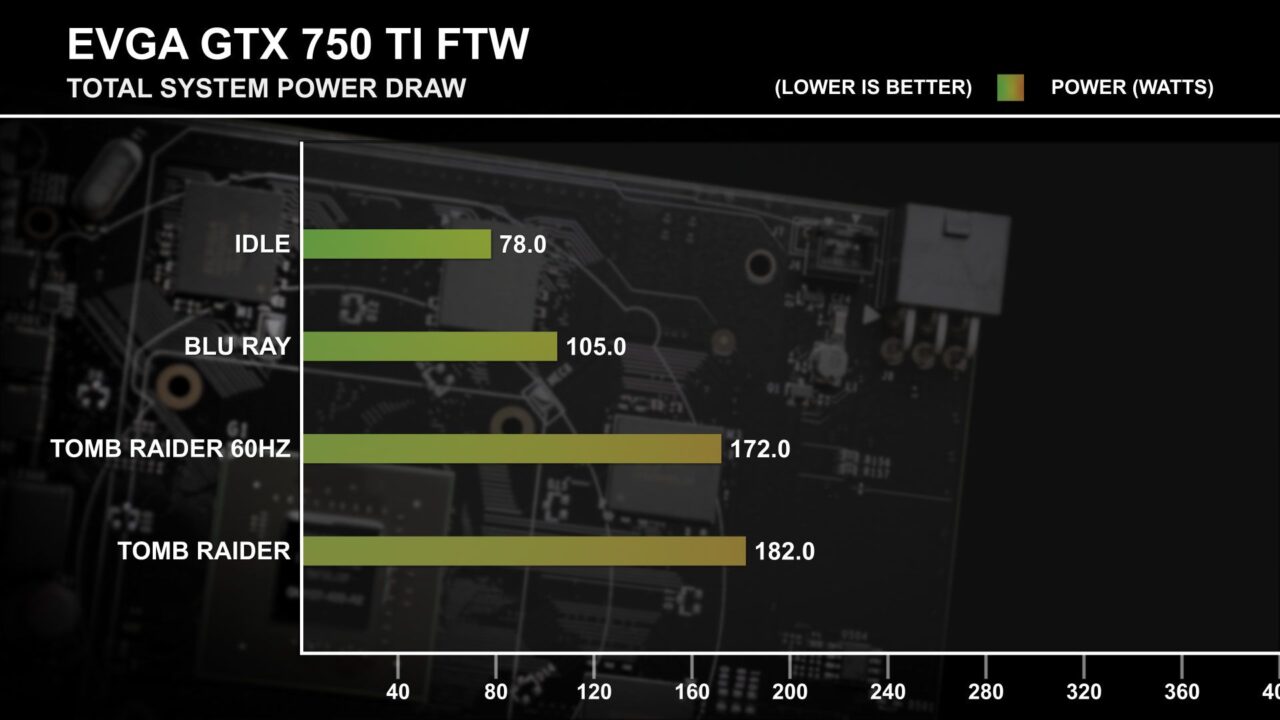
Total system power consumption is used to gauge the card’s electrical use. In idle, the system drew just 78 watts after 10 minutes of non-use. Playing back a BluRay movie file saw power increase to just 105 watts. Running 2013’s Tomb Raider at 1080p Ultra settings drew just 182 watts when uncapped, and 172 watts when capped to 60 FPS.

These power figures show good power efficiency. When uncapped the GTX 750 Ti FTW drew just 2.92 watts per FPS, and when capped to 60 FPS it became slightly more efficient at 2.87 watts per FPS.
GTX 750 TI FTW THERMALS.

As previously mentioned, EVGA’s ACX cooler would be at home on a much more power hungry GPU. As such it has no trouble cooling this card rated for just 60 watts. At idle it measured less than 8 degrees C over ambient, and under load in Tomb Raider ran at less than 26 degrees C over ambient.
GTX 750 TI FTW NOISE.

Fan speed went no lower than 42% in my testing, and under the heaviest load never went any higher. Therefore the noise levels at idle and under load were identical. It was a little noisier than necessary, though.
TROUBLE IN PARADISE.

At this point it’s important to point out the main drawbacks of this nearly 10-year old GPU. First, its API support is limited to D3D_FEATURE_LEVEL_11_0. That doesn’t mean it can’t run DirectX12 games, however. Games like Cyberpunk and Horizon Zero dawn are DX12 only, but are compatible with GPUs that have had DX12 added onto their initial DX11 support. Newer titles such as the PC port of Uncharted 4 is another DX12 only game, but also requires the GPU to support feature level 12_0. This requirement is increasingly common, and means moving forward there will be more games that the GTX 750 Ti simply won’t launch.

The next issue to note is the card’s inconsistent software stability. In my testing for the 20+ game comparison, I encountered graphical issues with Just Cause 2 of all games. No other GPU has experienced issues here, but the GTX 750 Ti rendered strange artifacting as can be seen in the image.
Power states were another point of concern. In an idle state, the GPU failed to reduce core clock speeds from its typical 3D load clock of over 1GHz. Power consumption likely could have been slightly better if downclocking was functioning properly. These two issues are quite small, but may not be entirely isolated, as other old GPUs I’ve tested don’t have these issues. They may be related to the GM107 being an early Maxwell product, or may be due to the card being on the trailing edge of software support, therefore not receiving the full quality assurance testing that more recent products get on the same driver release.
FINAL THOUGHTS ON THE GTX 750 Ti FTW.

In the end, seeing how the GTX 750 Ti has held up in this games is rather impressive, and proves that it earns its place as one of PC Gaming’s most beloved budget GPUs. It managed to keep performance over 30 FPS on average at 1080p in all but two games, Cyberpunk and Watch Dogs: Legion. Older titles like Tomb Raider run great, and GTA V at Normal settings is no challenge.
However, should anyone be looking to spend half way to a hundred dollars on this? Frankly, no. I picked up mine several months ago for roughly $15 used, and at that price it’s certainly worth it. The problem comes from the aggressive used prices from more modern GPUs like AMD’s RX 480 and 580, many of which can be found on eBay for as low as $60 – $80. That newer Polaris-based card would run circles around this little guy, and will much more confidently run newer games.
That’s it for this review, if you made it this far and you appreciate the detail I’ve gone into, leave me a comment and let me know. If you want to learn more about how the GTX 750 Ti performs, keep an eye out for the DX11 and DX12 comparison as well as the 21-Game benchmark.
